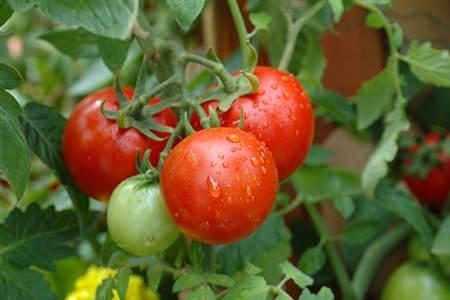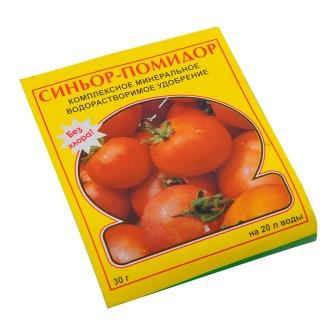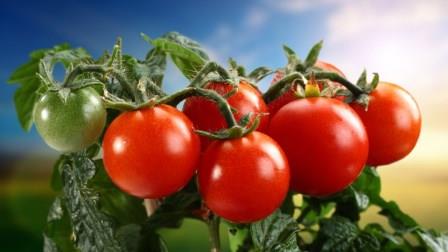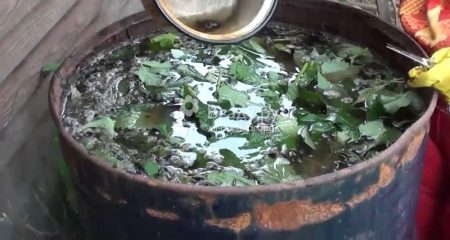 When the first buds appear on a tomato bush, the flowering period begins, and it becomes the most important. The future crop and the quality of the fruit depend on the correct color.
When the first buds appear on a tomato bush, the flowering period begins, and it becomes the most important. The future crop and the quality of the fruit depend on the correct color.
Many novice gardeners often wonder what to feed tomatoes during flowering and fruiting. We will try to maximize this topic.
Content
Seedlings
Spring has come, the planting season has begun, and everyone is trying to plant as many vegetables and fruits as possible on his garden plot. Many houses themselves grow seedlings for future tomatoes, someone buys ready-made. If you decide to buy ready-made seedlings, then you need to pay attention to its condition. The legs of the seedlings should be strong and low, the first brush of the plant should be located just above the lower part of the stem. It is necessary to take care of the soil into which the seedlings will be planted, the land must be fertile. To do this, it is fertilized with nitrogen-containing minerals, which are very necessary at the first stage of plant development.
Topping tomatoes during flowering and fruiting

Today on sale there is a huge selection of all kinds of drugs that are used to feed flowering tomatoes. Due to the huge assortment, it is sometimes easy for even an experienced gardener to get confused in them. It is necessary to figure out which mineral fertilizers to use for feeding tomatoes, so that instead of benefit they will not harm them.
Seedlings need nitrogen most of all, then future tomatoes need phosphorus and potassium. Therefore, you can use fertilizers containing such minerals as: double superphosphate, simple superphosphate, granular, potassium salt, potassium sulfate. Often, potassium monophosphate is used, which contains these two elements (33% potassium and 50% phosphorus).
Read more: growing tomatoes according to the method of I.M. Maslova.
Complex fertilizers for tomatoes are also successfully used during flowering and fruit setting. The main ones are:
- Wagon ": without chlorine, composed of nitrogen, phosphorus, magnesium, iron, potassium, zinc and copper;
- "Kemira Lux", the fertilizer is completely dissolved in water, use it as the main top dressing, but additionally using wood ash;
- "Effekton", an organic fertilizer obtained from composting peat, with the addition of phosphate rock and shale ash. It contains all the nutrients needed for tomatoes during flowering. It is also used for greenhouses.
- "Senior tomato" is perfect for tomatoes, consisting of phosphorus, potassium and nitrogen.
Everyone chooses the right fertilizer for themselves to feed the tomatoes, but you need to remember that:
- during flowering, they need less nitrogen and more phosphorus and potassium;
- fertilizers should contain humates and humic acids;
- choose fertilizers that do not contain chlorine;
- fertilizers should include magnesium, calcium, iron, sulfur and boron.
Foliar top dressing

Top dressing can be applied by watering under plants, this is root top dressing, and you can spray on a leaf, this is foliar top dressing. Both species are very useful for tomatoes. At the beginning of the growing season, it is best to use both types of feeding, alternating between them. Further, it is better to carry out only the root. Sometimes gardeners, especially beginners, do not know how to feed tomatoes during flowering and fruiting in the greenhouse, yes, in fact, there is no big difference.Just a greenhouse needs to be ventilated more often, especially after foliar top dressing. In order for any plant to get the maximum benefit from fertilizer, you need to use it correctly, spray only in the morning or evening. It is necessary to apply the settled tap water, rain or not chlorinated. For spraying use lighter solutions than for root dressing, so as not to cause burns to the leaves.
Read more: tomatoes in a polycarbonate greenhouse, planting and care.
Foliar top dressing is necessary for all plants, especially tomatoes, when the first buds appear. Fertilizing allows you to give the plant all the necessary nutrients, strengthen the green mass and prevent inflorescences from crumbling before the end of pollination. You can buy fertilizers or cook yourself, the main thing is to use top dressing with the lowest chlorine content or without it at all, they should dissolve well in water and not leave a residue. It can be both mineral and organic fertilizers.
Home foliar top dressing:
- in 9 liters of water, dilute 10 drops of iodine and add one liter of serum. To spray in the evening, previously it is good to water tomato bushes with settled water;
- make a solution of manganese and spray tomatoes;
- in 10 liters of serum add half a glass of sugar;
- take ten tablets of Trichopolum in a bucket, dilute and add a small bottle of green stuff.
These easy-to-prepare fertilizers, in addition to being very useful, will protect your tomatoes from diseases.
Root dressing

The first is carried out after ten days, when the seedlings were planted in the ground. The second in two weeks and the third, during flowering. Every two weeks, it is good to water the tomatoes with an ash solution. To prepare it, take a glass of ash, stir in a bucket of water. Leave to infuse for several hours. Once a month, you can do fertilizing with organic fertilizers, but watering the plant in advance. Before using chicken droppings or mullein, you need to water the bushes in the evening, if you plan to apply these fertilizers in the morning.
You can prepare a solution with chicken droppings as follows: pour about one third of the droppings into a bucket, fill with water and leave for a week. Then one liter of the prepared infused solution is diluted in a bucket of water and watered bushes. Mullein is prepared like this: a liter of manure is dissolved in a bucket of water, a spoonful of superphosphate and half a glass of ash are added. Watered at the rate of half a liter per bush.
Signs of a shortage of essential substances
Sometimes overfeeding can cause the same damage to tomatoes as lack. How to understand what tomatoes need and what fertilizers need to be applied. The plant itself will tell you what it needs, you just need to carefully monitor the bush and know what it lacks. So, for example, if the leaves begin to turn yellow, then the plant does not have enough nitrogen. If the leaves turn purple, then they lack phosphorus.
Folk remedies for feeding
Mineral fertilizers are very good for growing tomatoes, but they can not be called environmentally friendly. But you want to grow not only a delicious vegetable, but also healthy. Therefore, many refuse any mineral fertilizers and use only natural top dressing.
Yeast for feeding tomatoes
This product is used precisely during the flowering period of tomatoes, it is a kind of stimulator of growth and development.
100 grams of yeast is diluted in warm water (1 liter), insisted for several hours, and then diluted in a ten-liter bucket with warm water. At the beginning of flowering, 500 ml of solution is poured under each bush, but during fruit setting, you will need more - a liter for each tomato bush.
It is interesting: Russian gardens, raspberry miracle.
Dairy and iodine
Iodine as a top dressing of tomatoes can increase the number of ovaries, which means that the harvest will be much richer. Feeding tomatoes with iodine solution has long gained its popularity: it is a cheap fertilizer, and absolutely safe for humans. In addition, the solution protects the vegetable from diseases such as root rot and late blight. In addition, iodine has a wonderful effect on the growth and formation of ovaries. It takes only three drops per ten-liter bucket. And if you dilute 30-35 drops of iodine in a liter of fresh milk, add a spoonful of hydrogen peroxide and pour it all into a bucket of water, you will get a wonderful top dressing, which will also protect the plant from late blight.
Boric acid
Sometimes many people notice that tomatoes grow, but the setting does not occur. This comes from high temperatures, often this happens with tomatoes that grow in greenhouses or hot regions of our country. In this case, boric acid will come to the rescue. 10 g of powder is diluted in one liter of water, and then diluted in a bucket of water.
Infusion of herbs
If you do not know how to feed tomatoes during flowering, then opt for herbal infusion. On a barrel of 200 liters you will need five buckets of any grass, one bucket of mullein, one kilogram of fresh yeast and ash, 3 liters of whey. Insist a week or two, spend - one liter per tomato bush.
Wood ash

A wonderful fertilizer is ash, it is used to increase yield. Contains phosphorus, calcium and potassium. In addition, wood ash protects tomatoes from fungal diseases. It is brought into the grooves made along the beds at a distance of 15 cm from the bushes, ashes are sprinkled with earth and watered. You can use wood ash for watering: you will need a bottle of iodine, 10 g of boric acid and 1 liter of ash on a bucket of water. Everyone mixes and insists for a day, then use one liter of prepared top dressing, per one tomato bush.
Often ash is also used in pest control. 300 g of ash are poured with boiling water, kept for 30 minutes, then filtered. Bred in a bucket, filled with water, and adding a little laundry soap.
It is also used during the active growth of the plant, since during this period the vegetable needs fertilizer. 100 g of ash are diluted in 10 liters of water, half a liter of solution will be enough for one bush. During the tie, to improve the quality and taste of the fruit, ash is poured under the bush, at the rate of half a glass per square meter of beds.
We told you that we represent the fertilizing of tomatoes during flowering and fruit setting, a good harvest for you!
Read more: varieties of tomatoes with a photo and description for the Moscow region.




 Low-growing tomatoes, without pinching: 5 of the most delicious varieties
Low-growing tomatoes, without pinching: 5 of the most delicious varieties Why tomato seedlings grow poorly
Why tomato seedlings grow poorly We grow a tomato in a shell
We grow a tomato in a shell Growing tomatoes without watering according to the method of Kazarin
Growing tomatoes without watering according to the method of Kazarin